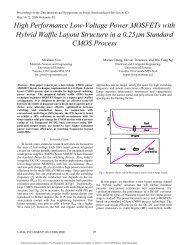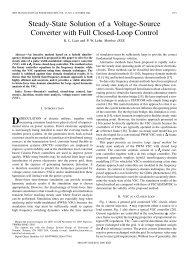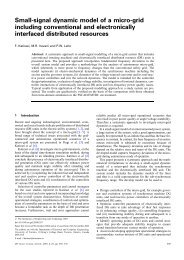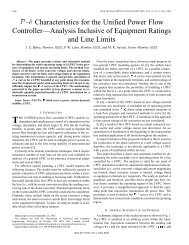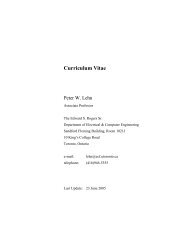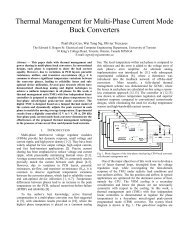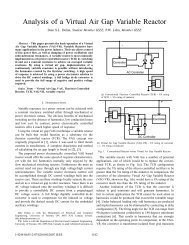Digital Current Control of a Voltage Source Converter With Active ...
Digital Current Control of a Voltage Source Converter With Active ...
Digital Current Control of a Voltage Source Converter With Active ...
You also want an ePaper? Increase the reach of your titles
YUMPU automatically turns print PDFs into web optimized ePapers that Google loves.
WU AND LEHN: DIGITAL CURRENT CONTROL OF A VOLTAGE SOURCE CONVERTER 1373<br />
first time combined the flexibility <strong>of</strong> pole assignment with inherent<br />
transient overcurrent protection. -plane analysis <strong>of</strong> a test<br />
system with characteristic parameters showed that the controller<br />
was robustly stable to variations in the grid interface inductance.<br />
Both simulation and experimental results showed that even at<br />
a low switching frequency relative to the resonant frequency,<br />
the proposed control structure can achieve well-damped, highbandwidth<br />
current control, and that cross-coupling can be minimized.<br />
Furthermore, the controller has good disturbance rejection,<br />
and regardless <strong>of</strong> overall performance provides instantaneous<br />
overcurrent protection even during severe transient disturbances.<br />
REFERENCES<br />
[1] M. Lindgren and J. Svensson, “Connecting fast switching voltagesource<br />
converters to the grid-harmonic distortion and its reduction,”<br />
in Proc. IEEE/Stockholm Power Tech Conf., Stockholm, Sweden, Jun.<br />
1995, pp. 191–196.<br />
[2] V. Blasko and V. Kaura, “A novel control to actively damp resonance in<br />
input LC filter <strong>of</strong> a three-phase voltage source converter,” IEEE Trans.<br />
Ind. Appl., vol. 33, no. 2, pp. 542–550, Mar./Apr. 1997.<br />
[3] E. Twining and D. Holmes, “Grid current regulation <strong>of</strong> a three-phase<br />
voltage source inverter with an LCL input filter,” IEEE Transactions<br />
Power Electron., vol. 18, no. 3, pp. 888–895, May 2003.<br />
[4] M. Lindgren and J. Svensson, “<strong>Control</strong> <strong>of</strong> a voltage-source converter<br />
connected to the grid through an LCL-filter-application to active filtering,”<br />
in Proc. Power Electron. Spec. Conf., Fukuoka, Japan, May<br />
1998, vol. 1, pp. 229–235.<br />
[5] M. Liserre, A. Dell’Aquila, and F. Blaabjerg, “Stability improvements<br />
<strong>of</strong> an LCL-filter based three-phase active rectifier,” in Proc.<br />
Power Electron. Spec. Conf., Cairns, Australia, Jun. 2002, vol. 3, pp.<br />
1195–1201.<br />
[6] T. Kawabata, T. Miyashita, and Y. Yamamoto, “<strong>Digital</strong> control <strong>of</strong> three<br />
phase PWM inverter with L-C filter,” in Proc. Power Electron. Spec.<br />
Conf., Kyoto, Japan, Apr. 1988, vol. 2, pp. 634–643.<br />
[7] S. Buso, S. Fasolo, and P. Mattavelli, “Uninterruptible power supply<br />
multiloop control employing digital predictive voltage and current regulators,”<br />
IEEE Trans. Ind. Appl., vol. 37, no. 6, pp. 1846–1854, Nov./<br />
Dec. 2001.<br />
[8] P. Dahono, Y. Bahar, Y. Sato, and T. Kataoka, “Damping <strong>of</strong> transient<br />
oscillations on the output LC filter <strong>of</strong> PWM inverters by using a virtual<br />
resistor,” in Proc. 4th IEEE Int. Conf. Power Electron. Drive Syst., Oct.<br />
2001, vol. 1, pp. 403–407.<br />
[9] E. Wu and P. Lehn, “<strong>Digital</strong> current control <strong>of</strong> a voltage source<br />
converter with active damping <strong>of</strong> LCL resonance,” in Proc. 20th Appl.<br />
Power Electron. Conf. Expo (APEC), Austin, TX, Mar. 2005, pp.<br />
1642–1649.<br />
[10] G. F. Franklin, M. L. Workman, and D. J. Powell, <strong>Digital</strong> <strong>Control</strong> <strong>of</strong><br />
Dynamic Systems, 2nd ed. Reading, MA: Addison-Wesley, 1990.<br />
[11] O. Kukrer and H. Komurcugil, “Deadbeat control method for singlephase<br />
UPS inverters with compensation <strong>of</strong> computation delay,” Proc.<br />
Inst. Elect. Eng., pp. 123–128, Jan. 1999.<br />
[12] A. T. Neto, J. Dion, and L. Dugard, “On the robustness <strong>of</strong> LQ regulators<br />
for discrete time systems,” in Proc. 30th IEEE Conf. Decision Contr.,<br />
Brighton, UK, Dec. 1991, vol. 3, pp. 2960–2965.<br />
[13] U. Shaked, “Guaranteed stability margins for the discrete-time linear<br />
quadratic optimal regulator,” IEEE Trans. Autom. Contr., vol. AC-31,<br />
no. 2, pp. 162–165, Feb. 1986.<br />
[14] M. Liserre, F. Blaabjerg, and S. Hansen, “Design and control <strong>of</strong> an<br />
LCL-filter based three-phase active rectifier,” in Proc. 36th IAS Annu.<br />
Meeting, Chicago, IL, Oct. 2001, vol. 1, pp. 299–307.<br />
Eric Wu (S’03–M’05) was born in Taipei, Taiwan, R.O.C., in 1978. He received<br />
the B.A.Sc. and M.A.Sc. degrees in electrical engineering from the University<br />
<strong>of</strong> Toronto, Toronto, ON, Canada, in 2002 and 2005, respectively.<br />
Peter W. Lehn (SM’05) received the B.Sc. and M.Sc. degrees in electrical enginnering<br />
from the University <strong>of</strong> Manitoba, Winnipeg, MB, Canada, in 1990<br />
and 1992, respectively, and the Ph.D. degree from the University <strong>of</strong> Toronto,<br />
Toronto, ON, Canada, in 1999.<br />
From 1992 to 1994, he was with the Network Planning Group, Siemens AG,<br />
Erlangen, Germany. Presently, he is an Associate Pr<strong>of</strong>essor at the University <strong>of</strong><br />
Toronto.




